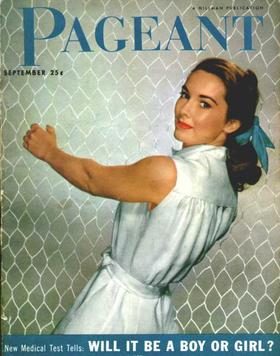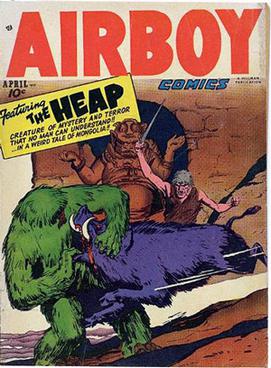
Fawcett Comics, a division of Fawcett Publications, was one of several successful comic book publishers during the Golden Age of Comic Books in the 1940s. Its most popular character was Captain Marvel, the alter ego of radio reporter Billy Batson, who transformed into the hero whenever he said the magic word "Shazam!".

Airboy is a fictional Golden Age aviator hero of an American comic book series initially published by Hillman Periodicals during the World War II, before ending his initial run in 1953. The hero was the costumed identity of crack pilot Davy Nelson II, and created by writers Charles Biro and Dick Wood with artist Al Camy.

Charles Biro was an American comic book creator and cartoonist. He created the comic book characters Airboy and Steel Sterling, and worked on Daredevil Comics and Crime Does Not Pay at Lev Gleason Publications.
Notable events of 1951 in comics.

Atlas Comics was the 1950s comic-book publishing label that evolved into Marvel Comics. Magazine and paperback novel publisher Martin Goodman, whose business strategy involved having a multitude of corporate entities, used Atlas as the umbrella name for his comic-book division during this time. Atlas evolved out of Goodman's 1940s comic-book division, Timely Comics, and was located on the 14th floor of the Empire State Building. This company is distinct from the 1970s comic-book company, also founded by Goodman, that is known as Atlas/Seaboard Comics.

Fiction House was an American publisher of pulp magazines and comic books that existed from the 1920s to the 1950s. It was founded by John B. "Jack" Kelly and John W. Glenister. By the late 1930s, the publisher was Thurman T. Scott. Its comics division was best known for its pinup-style good girl art, as epitomized by the company's most popular character, Sheena, Queen of the Jungle.

True Confessions is a confession magazine targeted at young women readers. It was originally published by Fawcett Publications, beginning in 1922.
Thrilling Publications, also known as Beacon Magazines (1936–37), Better Publications (1937–43) and Standard Magazines (1943–55), was a pulp magazine publisher run by Ned Pines, publishing such titles as Startling Stories and Thrilling Wonder Stories.
St. John Publications was an American publisher of magazines and comic books. During the 1947-1958 existence of its comic-book division, St. John established several industry firsts. Founded by Archer St. John, the firm was located in Manhattan at 545 Fifth Avenue. After the St. John comic books came to an end in 1958, the company continued to publish its magazine line into the next decade. Flying Eagle Publications was a magazine affiliate of St. John Publications. Comic book imprints included Approved Comics, Blue Ribbon, and Jubilee Publications.

Pageant was a 20th-century monthly magazine published in the United States from November 1944 until February 1977. Printed in a digest size format, it became Coronet magazine's leading competition, although it aimed for comparison to Reader's Digest.

Fred Kida was a Japanese-American comic book and comic strip artist best known for the 1940s aviator hero Airboy and his antagonist and sometime ally Valkyrie during the period fans and historians call the Golden Age of Comic Books. He went on to draw for Marvel Comics' 1950s iteration, Atlas Comics, in a variety of genres and styles, and then again for Marvel superhero titles in the 1970s. He drew the company's The Amazing Spider-Man newspaper comic strip during the early to mid-1980s. Kida also assisted artist Dan Barry on the long-running strip Flash Gordon from 1958 to 1961 and then again from 1968 to 1971.

The Heap is the name of several fictional comic book muck-monsters, the original of which first appeared in Hillman Periodicals' Air Fighters Comics #3, during the period fans and historians call the Golden Age of Comic Books. The Heap was comics' first swamp monster.
Anthony Louis DiPreta was an American comic book and comic strip artist active from the 1940s Golden Age of comic books. He was the longtime successor artist of the comic strip Joe Palooka (1959–84) and drew the Rex Morgan, M.D. daily strip from 1983 until DiPreta's retirement in 2000.
Lancer Books was a publisher of paperback books founded by Irwin Stein and Walter Zacharius that operated from 1961 through 1973. While it published stories of a number of genres, it was noted most for its science fiction and fantasy, particularly its series of Robert E. Howard's Conan the Barbarian tales, the first publication of many in paperback format. It published the controversial novel Candy by Terry Southern and Mason Hoffenberg, and Ted Mark's ribald series The Man from O.R.G.Y. Lancer paperbacks had a distinctive appearance, many bearing mauve or green page edging.
Ace Magazines was a comic book and pulp-magazine publishing company headed by Aaron A. Wyn and his wife Rose Wyn. The Wyns had been publishing pulp fiction under the Periodical House and A. A. Wyn's Magazine Publishers names since 1928, and published comics between 1940 and the end of 1956.

Crime comics is a genre of American comic books and format of crime fiction. The genre was originally popular in the late 1940s and early 1950s and is marked by a moralistic editorial tone and graphic depictions of violence and criminal activity. Crime comics began in 1942 with the publication of Crime Does Not Pay published by Lev Gleason Publications and edited by Charles Biro. As sales for superhero comic books declined in the years after World War II, other publishers began to emulate the popular format, content and subject matter of Crime Does Not Pay, leading to a deluge of crime-themed comics. Crime and horror comics, especially those published by EC Comics, came under official scrutiny in the late 1940s and early 1950s, leading to legislation in Canada and the United Kingdom, the creation in the United States of the Comics Magazine Association of America and the imposition of the Comics Code Authority in 1954. This code placed limits on the degree and kind of criminal activity that could be depicted in American comic books, effectively sounding the death knell for crime comics and their adult themes.
Notable events of 1943 in comics.
"It" is a horror short story by American writer Theodore Sturgeon, first published in Unknown of August 1940. The story deals with a muck-monster that emerges from a swamp, and terrorizes a family who lives nearby. The creature has no emotions, and is simply curious about the things that it observes. Its terrifying strength allows it to grab animals and people and tear them apart, to see how they work. Ultimately, the creature is revealed to have formed around a human skeleton.
Ben Oda was a Japanese-American letterer for comic books and comic strips.

Alden Spurr McWilliams generally credited as Al McWilliams and A. McWilliams, was an American comics artist who co-created the first African-American lead character of a comic strip. He won the National Cartoonists Society's 1978 award for Comic Book: Story.










